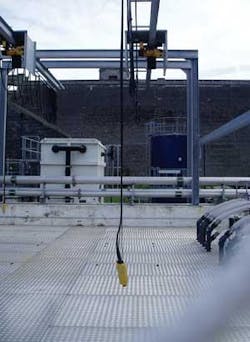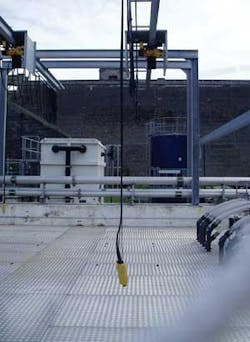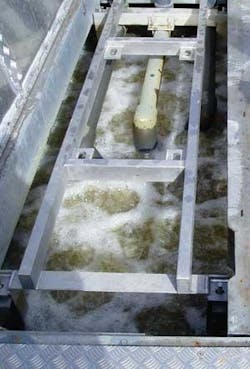The UK division of Canadian company Zenon developed a technique to retrofit ultrafiltration membranes into clarifier basins, which simplified installation, reduced costs and minimised environmental and visual effects at a potable water project in the Channel Islands.
Engineers from Purac Ltd (UK) and Zenon Environmental (UK) Ltd retrofitted ZeeWeedTM ultrafiltration (UF) membranes into existing storage facilities at the St. Saviours water treatment works on Guernsey, Channel Islands, UK, using a technique developed by Zenon to overcome potential problems.
The States of Guernsey Water Board (SGWB) chose the membrane to meet the challenges of variable feed water quality and removal of turbidity, and the pathogens Cryptosporidium and Giardia. The project provides 13 million litres per day of potable water, which meets half the demand of the island’s population of 60,000.
Up until the mid-1990s, membrane fibres for potable water production were supplied housed in pressurised systems. These consisted of membrane modules installed in specialised pressure vessels, and the process water to be treated was pumped across the membrane surface. These systems consisted of a number of membrane vessels either mounted vertically or horizontally, often housed indoors on large skid-mounted units. Frequently, large green field sites had to be used to locate the new facilities required.
Zenon developed the technique of immersing UF hollow fibre membranes in process fluids to overcome these disadvantages by reducing footprint and system cost, and simplifying installation and subsequent access requirements. The ZeeWeed membrane cassettes are designed specifically to be immersed into the process fluid and comprise thousands of membrane hollow fibres, which hang loosely in the standard cassettes. The membrane hollow fibres, manufactured from polyvinyl di-chloride (PVDF) have a nominal pore size of 0.04 µm and filter raw water from outside to inside, so that suspended particles remain on the outside of the membrane fibre, thus preventing fibre blockage.
The UK Secretary of State has approved ZeeWeed membranes for use in public water supplies. Zenon UK can supply membrane cassettes and ancillary equipment, manage the overall project, and provide commissioning support and ongoing system monitoring. Alternatively, cassettes can be supplied via other companies, as at St. Saviours on Guernsey, where the system was designed by Purac and the ZeeWeed membranes were installed at the heart of the process in Spring 2004.
Immersed membranes can be installed into specially designed tanks or retrofitted into existing storage facilities; however retrofitting membranes by immersing them in an existing tank poses some challenges for periodic cleaning. These challenges have been effectively overcome at the St. Saviours water treatment works.
The membranes are regularly back-flushed with a combination of permeate (treated water) and coarse bubble aeration to keep the membrane surface clean and extend the time required between chemical cleans, which were anticipated to be required on a quarterly basis.
The chemical cleaning process uses citric acid and requires a combination of recirculation and soaking to remove foulants from the membrane surface. This procedure had always been carefully controlled in pressurised systems, due in part to the volume of the system as a whole being minimised so dilution rates could be optimised, temperature controlled and chemical consumptions minimised.
At St. Saviours, the membranes were retrofitted into existing clarifier basins. The pre-existing clarifier basins were relatively deep and this meant it was impractical to undertake chemical cleaning in-situ as the volume of chemical solution required would have been large and expensive to dilute and heat.
The St. Saviours ZeeWeed system design has two key features to overcome potential chemical cleaning problems. Firstly, membrane cassettes are easily removed from the clarifier basins for external chemical cleaning using the crane system supplied. Membranes are supplied in easy-to-lift cassettes for periodic removal and cleaning that is done on a rotating basis without affecting the overall process.
Secondly, extensive pilot testing on site has allowed a continuous sequence of back-flushing, aeration and chlorination to be developed, which is now used in-situ to avoid organic and in-organic foulants precipitating for longer periods between the chemical cleans. This minimises the frequency of chemical cleaning required. Back flushing with coarse bubble aeration is undertaken on a 10-second batch cycle with chlorine periodically dosed into the permeate that is used in the sequence.
The St. Saviours system has now operated for seven months without the need for external chemical cleaning, as confirmed by the SGWB Director of Water Services, Mr. Andrew Redhead. This demonstrates that the short cycle back flushing is working effectively. The operating cost evaluation for the plant was based on chemical cleans being required on a quarterly basis.
In addition, the SGWB specified pilot trials to fully characterise the nature and variability of the feed water. Membrane technology was required to ensure the absence of pathogens, Cryptosporidium and Giardia, and to eliminate the effects of algal blooms and turbidity spikes, which caused repeated problems for the pre-existing clarification system.
The feed water for the St. Saviours ZeeWeed membrane system originates from St. Saviours reservoir, which has been the major water storage site on Guernsey since 1938. The reservoir provides one-third of the island’s water storage with the remainder comprising old quarry sites and small underground storage reservoirs with pumped connections to the treatment plant. This works purifies half the potable water requirement for the population of Guernsey.
In addition to compactness, SGWB selected Zenon UF membranes because of their robustness, ease of operation, and straightforward maintenance procedures. Raw water is screened to 40 µm and dosed with coagulant and flocculant before being drawn through the membranes by self-priming extraction pumps. ZeeWeed systems operate under a gentle negative pressure by applying a slight vacuum to the inside of the hollow fibres. Particulate contamination is retained in the existing basins using the combination of back flushing and coarse bubble aeration before being transferred to an existing wash water recovery system. Filtrate is discharged to an existing filtrate collection channel.
The ZeeWeed system typically achieves a log reduction value (LRV) of at least 4, corresponding to 99.99 % removal of Giardia and Cryptosporidium. This compares to a maximum LRV of 2 (99% removal) typically achieved by pre-existing conventional processes employed at St. Saviours.
An in-built integrity testing system provides operators with confidence in pathogen removal efficiency within the treatment works. The system uses a pressure decay test (PDT) consisting of initially pressurising the inside of the hollow fibres with air and isolating the permeate. The rate of pressure decay is then measured and the result is used in the system control software to calculate the LRV.
This integrity test complies with the US Environment Protection Agency’s Surface Water Treatment Rule, which requires the PDT be conducted at a test pressure sufficiently high to have 3-µm sized leaks contribute to the pressure decay. This ensures that the PDT can verify the rejection of Cryptosporidium and Giardia since Cryptosporidium oocysts have a minimum diameter of 4 µm, with Giardia cysts at 6 µm.
The St. Saviours project shows how immersed membranes can be effectively retrofitted into existing storage facilities whilst providing for effective cleaning in terms of regular back-flushing and periodic chemical cleaning. The ZeeWeed membranes were retrofitted to simplify installation, reduce costs and minimise environmental and visual impact. The membrane was chosen to meet the challenges of variable feed water quality and removal of turbidity, and the pathogens Cryptosporidium and Giardia. In-built integrity testing procedures ensure confidence in the treated water provided to SGWB’s customers.
In addition to potable water supply, Zenon systems are also effectively employed in the UK and around the world in wastewater treatment, and in various industrial and water re-use applications.
Author’s Note
Jack Noble is Managing Director at Zenon Environmental (UK) Limited, located in Sheffield, England. For more information, contact Jennie Peace by e-mail at: [email protected].





